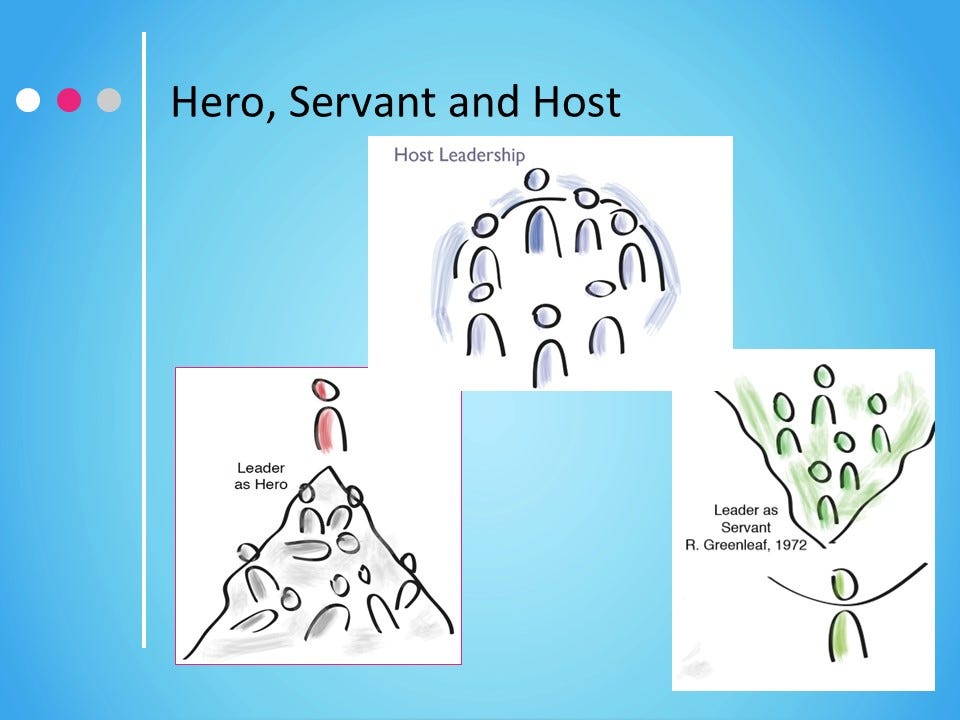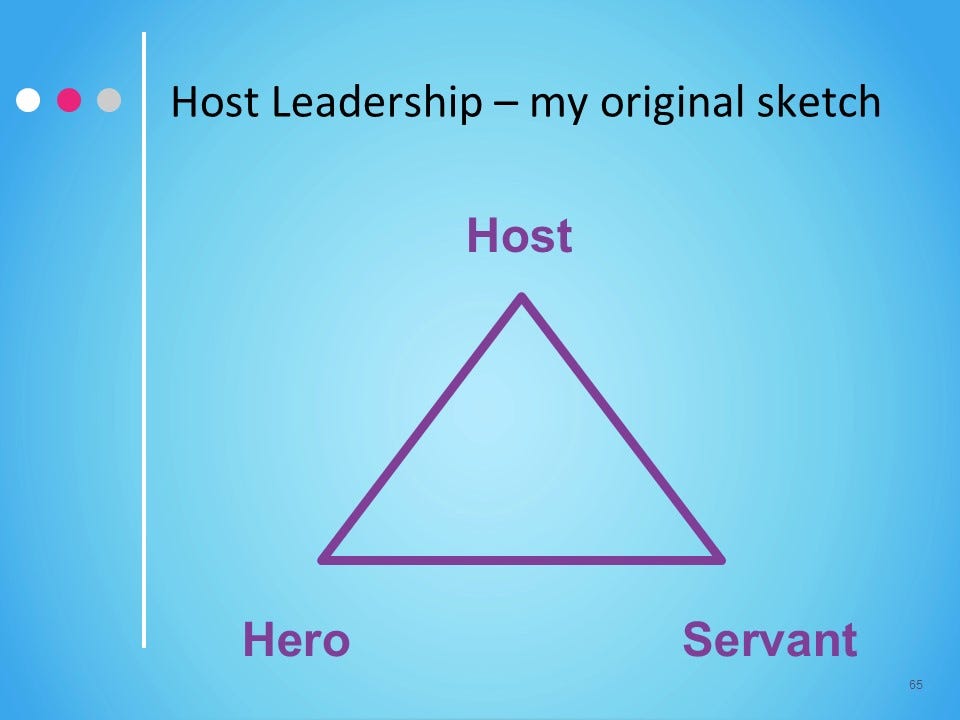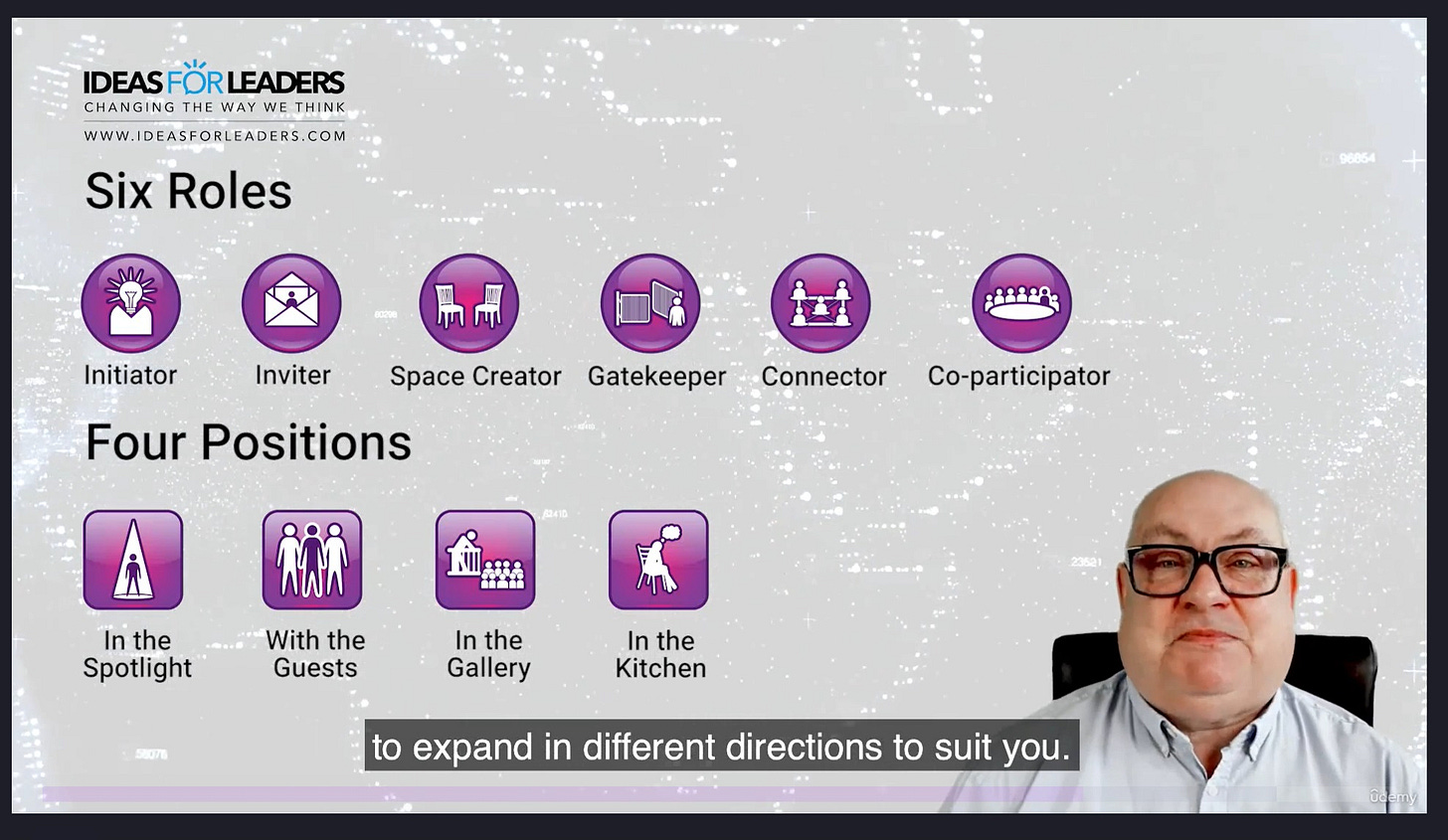79. “I’m trying to lead as a host. How can I help my people take ownership more?”
This real-life question is well worth taking a moment to consider through the lens of Host Leadership
This week’s piece has ideas about tackling a common difficulty at work, and news of the return of my online Host Leadership video course.
I received an inquiry last week from Pascal in Switzerland. He wrote:
As part of a university leadership programme I have been studying Host Leadership in depth, exploring your book, TED Talk and articles. I have applied these principles in the context of the federal administration, which is heavily shaped by regulations and predefined structures.
One challenge I am facing is that, despite carefully crafting attractive and optional invitations, employees tend to hand responsibility back to me instead of actively seeking solutions themselves. I found your insights on Dynamic Steering particularly thought-provoking. However, I am wondering whether I am overlooking or underutilising a key aspect of Host Leadership that could help strengthen autonomy and engagement in my team.
Given your extensive experience, I would greatly appreciate any insights or practical advice on how to reinforce ownership while maintaining a supportive leadership role.
What an interesting (and dare I say it, widely applicable) question! I replied to Pascal, and here’s what happened.
Host Leadership
As regular readers may know, leading as a host is humane and flexible way to build engagement, performance and results. Rather than the very traditional he-man heroic leadership approach (now making an unwelcome return to international relations) or the counter-point servant leadership, host leadership is about bringing people together around a challenge which affects the whole group. So, while the first two options can be thought of as based on triangles, host leadership is more about a circle.
Hosts have to be able to act in all kinds of ways to suit the context. Often they will be making sure their ‘guests’ have what they need and know what’s going to happen next. Other times they may need to act more heroically, taking a strong lead where the group is threatened or something unexpected and unwelcome happens. Indeed, the very first picture I drew about Host Leadership on that morning in February 2003 was this one – how host can encompass both hero and servant, and all the options in between.
This leads to perhaps THE key question for a host leader:
Are you going to step forward or step back next?
Both stepping forward and stepping back are part of the host leader’s repertoire. We step forward to set things up, to get people’s attention, to frame the situation. Then we may be able to step back, allowing others to step forward into the space we’ve created to start to make their contributions.
A spectrum of options
This spectrum shows us lots of possibilities from which to choose. One key aspect of leading as a host is to build up people’s engagement and willingness to contribute and then take a lead for themselves. When you start acting as a host, people may take a little while to respond – they want to know they can trust you and that there won’t be any unexpected and unpleasant surprises coming their way if they do step forward.
Pascal is asking about how to get people to ‘take ownership more’, which means to become more self-aware and self-driven, taking more initiative in taking things forward themselves (rather than referring back to the leader all the time). This is a process of learning for all involved – most people won’t just jump right in immediately.
One way to look at it is to see a spectrum of possibilities for the host leader, in terms of how involved they are:
Leave it up to everyone what they do _______ Just tell people what to do
Of course there is a lot of distance between those basic possibilities, and it’s in that space that host leaders dance with stepping forward and stepping back. In Pascal’s case, it seemed to me that he may be stepping back too quickly or too often. Stepping forward to agree what’s important, what’s going to happen next and so on is a key role of the host leader, particularly as everyone is getting used to this stance. Then, as people get used to this way of working, they may be able to step back more/earlier. However, the team will be keen to see that they are carrying out their leadership role rather than simply abdicating it.
Some points in between the two extreme options on the scale above (working right to left) might include:
Say what needs doing and get people to sort out who’s going to do what
Set out some initial possibilities and see who’s interested to be part of them
Ask what people think are the options before helping them into their roles
Have a conversation about useful ways to divvy out what needs to be done
Ask people to come along to the next meeting with options
Talk about people’s past experiences and how this might be useful in the current situation.
Whichever way, it’s about encouraging people to step forward – which you can do by stepping forward yourself to confidently set the scene and then stepping back. It’s like the difference between going to someone’s house for dinner and them saying “Please come through to the dining room where the food is! We have veggie or non-veggie.” and “Erm… I don’t have anything prepared, so maybe we can all go the shops…”. Either of those might work, but the former is a better way into building relationship and trust with new people, or those accustomed to a more regimented style of working. And it pays to watch out for people’s skills and strengths as you build the new way of working.
Lessons from the nuclear industry
In the early 1990s, the governing UK Conservative party set about the privatisation of UK electricity industry including the nuclear power element where I worked. We were told that a ‘culture change’ would be required for working in the new context where financial drivers would be as important as safety and technical innovation. Consultants were brought in to build this process, which was one of the most frustrating experiences I’ve ever had. The consultants (I won’t embarrass them by naming them) said that this kind of change had to be achieved in some mysterious way without telling anyone what was going on, offering them training or any kind of route map. They seemed to revel in undermining anything we did and destabilising anything that might have been thought about as progress. I still don’t know what they were trying to do.
What they WEREN’T doing was utilising the key strength of the professionals in the nuclear industry. People are very good at following instructions and procedures. (This is a good thing! Even if it can sometimes lead to erring on the side of caution). I have often thought that people would have responded better to something clearer -rather than not being told what to do; they could have been encouraged to work in a different way with some clear guidelines. (Presumably this would not have been a ‘culture change’ in the terms of the consultants.)
Whatever, it didn’t work; the industry didn’t survive, being split into two and then three parts (like Gaul) with the operational part finally being taken over, appropriately, by Electricité De France (EDF). RIP the British nuclear industry.
Looking for small signs
On this journey with using Host Leadership to build engagement is to look for any small signs that some people in your team are interested to take initiative and do things for themselves. You could then start by working with them to do more of that (and also encourage the others over time that this is a good thing and not a trap for them to fall into).
I remember early in my solution focused (SF) career I was coaching someone who was responsible for a university library. She wanted her people to take more responsibility. I asked when times when did take responsibility (a ‘Counters’ question in SF). She replied very quickly:
“They hardly ever take responsibility…”
One of the key skills of an SF coach is to listen out for tiny signs that something is (or has been) working. Look carefully at the sentence above. “They hardly ever take responsibility…” That doesn’t say that they NEVER take responsibility; on the contrary, it says that they do, but rarely. I didn’t want to let that go, so I asked, “And when DO they take responsibility…?”. The expression on the librarian’s face changed in an instant. “Aha!” she cried. “I know what to do!”. She seemed so confident that we left it at that. I have often wished I’d probed a bit more so I could tell you what she’d realised.
What happened next
I shared some of these ideas with Pascal. He replied after a couple of days:
After reading your message, I realised that I have indeed been stepping back too quickly and, in a way, offloading responsibility rather than dynamically steering the process. You pinpointed it perfectly! Your suggestion to actively look for small signs of initiative within my team and build on them really resonated with me—it also helped me see the direct connection to the solution-focused approach. Brilliant! This perspective rounds off my seminar paper in the best possible way.
I’d also love to share a recent success story with you: Today, I facilitated a cross-departmental workshop, designed around the key principles of Host Leadership. The initial situation resembled a wicked problem. I placed particular focus on creating and holding the space effectively, establishing structured yet flexible conditions while maintaining a not-knowing stance, and making past progress visible through a short reflection exercise at the start. During the session, I remained open to adjusting my planned agenda in response to the discussion, should more useful next steps emerge.
I can honestly say that I have never felt such a strong dynamic and constructive engagement in a workshop before—and the participants’ feedback reflected the same experience. These past months of immersing myself in Host Leadership have had a tremendous impact on my development as a leader. Thank you for your inspiring work!
Conclusions
Leading as a host is a journey both of learning about yourself and helping others into the way of working. These things are best taken in small steps. As confidence and trust grows, everyone can play bigger and different roles in contributing to success. Look out for small signs that things are moving. Help your people engage gradually – you may find that they turn out to be keener than you thought.
Dates and mates
My online Host Leadership video course is back up on Udemy after a break. It’s very exciting to be able to point you towards it once again. The course has eight video modules, each with three sections, with me taking you through the various dimensions of Host Leadership and helping you think about how it can fit with your current situation. Do take a look. There is a free preview available. And it’s very moderately priced too IMHO.





